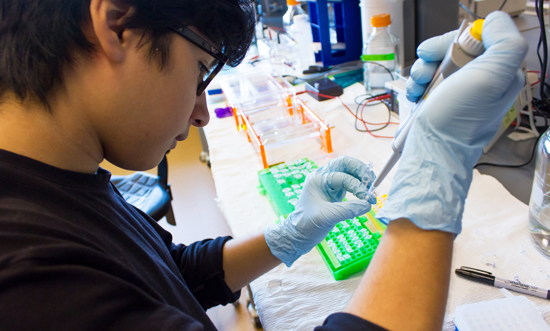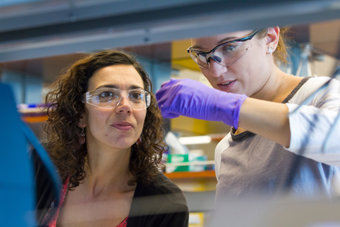UAlbany Research Seeking Answers for Neurodegenerative Diseases
 |
|
The groundbreaking RNA Institute offers students an opportunity to learn about technology development, drug discovery, and diagnostics for the most difficult and drug-resistant diseases. (Photos by Paul Miller)
|
ALBANY, N.Y. (June 27, 2016) – Earlier this month, the world lost Olympic and world heavyweight boxing champion and activist Muhammed Ali following a long battle with Parkinson’s disease. In 1984, the former heavyweight boxing champion began experiencing slurred speech, tremors, slowness of movement and unexplained fatigue. After a battery of tests by some of the leading neurologists in the world, Ali was determined to be suffering from Parkinsonism – the umbrella term for a host of neurodegenerative illnesses that share similar symptoms. More than 30 years later, a cure for Parkinson’s disease remains elusive, but scientists continue to seek breakthroughs on treating the disease and managing its symptoms.
At UAlbany, researchers work to break down the mysteries surrounding this elusive condition, as well as other similar difficult-to-treat neurodegenerative diseases.
Center for Neuroscience Research
At the Center for Neuroscience Research (CNR), scientists are working to determine the factors that underlie and influence neurodegeneration. Center associates investigate the formation of synaptic connections, and also examine how neurons make connections, how excess connections are removed, how neurons recover from damage, and how such neural connections modulate or control behavior. These research approaches are relevant for understanding the factors causing such conditions as Alzheimer's disease, epilepsy, strabismus, amblyopia, Lou Gehrig’s disease, Parkinson's disease and diabetes that lead to new treatments. The Center promotes the exchange of research findings, especially the knowledge of new techniques, and encourages students to enter careers in neuroscience research.
 |
|
The goal of researchers at the RNA Institute is to translate discovery research into new therapies for central nervous system repair, including age-related macular degeneration, spinal cord injury, multiple sclerosis and Parkinson’s disease.
|
Students at CNR Director Greg Lnenicka’s lab are working to understand the mechanisms of synaptic changes in the brain – a key role in neural development, learning and memory in humans. As the complexity of the mammalian brain makes it difficult to study individual synapses, Lnenicka’s research team uses the fruit fly, where single synapses can be studied and the activity and molecular components of these synapses can be altered using genetic techniques. They use imaging and electrophysiological techniques to examine changes in synaptic structure and function. A particular focus of the research is the role of intracellular calcium in synapse strengthening. Calcium accumulation in the brain has also been linked to Alzheimer’s disease and similar dementias in humans, making an increased understanding of its role critical to one day finding a cure for the disease and other neurodegenerative conditions.
Similarly, UAlbany’s RNA Institute is the leading research center dedicated to RNA technology development worldwide for novel therapeutics and diagnostics. Just as research on DNA has led to an untold number of discoveries, new products, and medicines, RNA has the potential to revolutionize biomedical science and cancer research.
The technology currently under development at the RNA Institute is applicable to a broad spectrum of diseases, from breast cancer to neurodegenerative disorders such as Parkinson’s, Lou Gehrig’s disease, and Alzheimer’s disease. The groundbreaking facility at UAlbany makes New York a national leader in RNA Science, technology development, drug discovery, and diagnostics for the most difficult and drug-resistant diseases.
At The RNA Institute, the focus is on developing tools and analytics for moving RNA therapeutics down the drug candidate pathway. The Institute disseminates these tools and technologies through collaborations with more than 400 researchers nationwide in a breadth of disciplines and disease focuses, critical to human health. The researchers span organizations worldwide including UAlbany's College of Arts and Sciences and the School of Public Health, as well as the New York State Department of Health’s Wadsworth Center, Rensselaer Polytechnic Institute, the Neural Stem Cell Institute and Albany Medical Center. Their goal is to translate discovery research into new therapies for central nervous system repair, including age-related macular degeneration, spinal cord injury, multiple sclerosis and Parkinson’s disease.
These collaborations are paying dividends, for example:
- In 2015, Professor of Chemistry Igor Lednev and colleagues at Albany Medical Center developed a new method for noninvasive diagnostics of Alzheimer’s disease. Taking Raman spectra of blood samples, the researchers were able to distinguish people with Alzheimer’s disease from healthy controls as well as from people with other forms of dementia.
- Also in 2015, the RNA Institute announced a partnership with Rensselaer, N.Y.-based Athghin Biotechnology, Inc. and the Neural Stem Cell Institute to find answers for millions of children afflicted with neuro-developmental diseases worldwide. Together, the researchers will collaborate to develop a new stem cell-based method to rapidly and sensitively analyze the effects of thousands of chemical compounds to determine any detrimental health effects on brain development.
The Center for Neuroscience Research and the RNA Institute remain committed to fostering the next generation of scientists by providing research opportunities at the undergraduate, graduate, doctoral and post-doctoral levels in areas ranging from anatomy, electrophysiology and behavior to biochemistry, genetics, endocrinology and molecular biology.
![]() For more news, subscribe to UAlbany's RSS headline feeds
For more news, subscribe to UAlbany's RSS headline feeds
A comprehensive public research university, the University at Albany-SUNY offers more than 120 undergraduate majors and minors and 125 master's, doctoral and graduate certificate programs. UAlbany is a leader among all New York State colleges and universities in such diverse fields as atmospheric and environmental sciences, business, education, public health,health sciences, criminal justice, emergency preparedness, engineering and applied sciences, informatics, public administration, social welfare and sociology, taught by an extensive roster of faculty experts. It also offers expanded academic and research opportunities for students through an affiliation with Albany Law School. With a curriculum enhanced by 600 study-abroad opportunities, UAlbany launches great careers.


